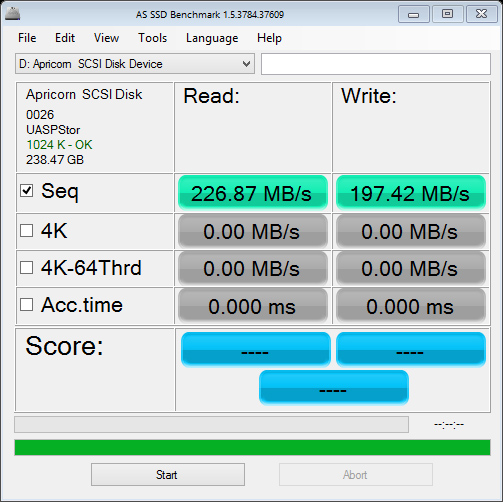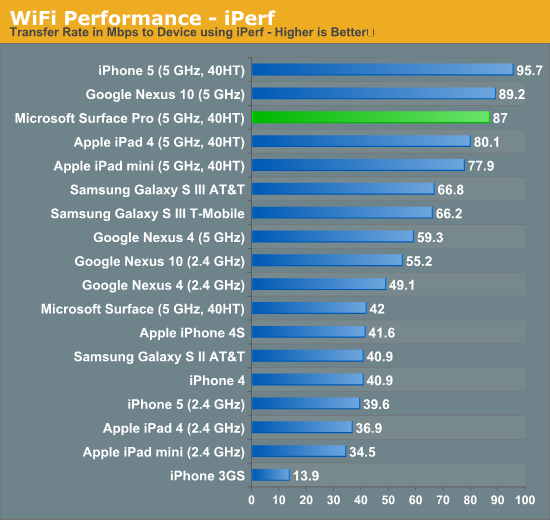Microsoft Surface Pro Review
by Anand Lal Shimpi on February 5, 2013 9:00 PM ESTFans and Thermals
While Surface RT was passively cooled, Surface Pro features two integrated fans to cool the 17W Core i5-3317U. For most light use cases, those two fans will remain spun down and you can’t hear them. Do any sort of serious multitasking or start using Surface Pro as a real PC instead of a tablet and you’ll quickly hear them spin up. Fan noise is audible but not annoying - it’s very similar to the sound you’d hear out of any ultraportable with a couple of tiny fans spinning up.
In landscape mode with the Type Cover attached, Surface Pro draws in cool air from the sides and exhausts it out of the top of the device. Rotate the device into portrait mode and the fans will switch directions, drawing in cool air from the long edge and exhausting it out of the short edges. The fan direction switch is triggered in tandem with display rotation, so as soon as you see your display rotate you’ll hear the fans change direction.
The two fans do a good job keeping the CPU cool (I saw typical CPU core temperatures between 50C - 60C), but Surface Pro does get warm. I measured a max surface temperature of 41.8C while running 3DMark 11. That’s towards the top of the unit, around where the Core i5 CPU is located. On the edges I measured a max surface temperature of 36.5C. There’s no getting around the fact that Surface Pro gets warm, noticeably more so than the 4th generation iPad. It never gets uncomfortably hot however.

Despite being a tablet, the Core i5-3317U had no issues hitting its max turbo frequency of 2.6GHz. I even saw 2.75GHz for a very short period of time (remember, Intel’s Turbo Boost can exceed max TDP until the silicon gets up to temperature).
Storage and USB 3.0
Surface Pro ships with a micro SDXC slot along the edge of the device. Courtesy of Intel’s HM77 chipset, you also get a full blown 6Gbps SSD and a single USB 3.0 port - both significant upgrades over Surface RT. In my 128GB review sample, Surface Pro features a Micron C400 SSD. Microsoft is sourcing from multiple SSD vendors and claims to be shipping with optimized firmware, but I don’t know what other vendors are in the mix. Update: It looks like the C400 SSD is an mSATA drive, likely similar to the one we reviewed here a while back.

To put this in perspective, the C400 is in the same class of storage device that’s used in Apple’s MacBook Air. Although some ARM based SoCs feature SATA interfaces, pretty much all of them are paired with eMMC based NAND storage solutions that are horribly slow. The fastest sequential transfer rates I’ve managed on the 4th generation iPad are typically on the 20 - 30MB/s range, whereas the C400 in the Surface Pro is good for over 400MB/s in reads and just under 200MB/s in writes.

There’s been a lot of debate over the amount of free space available on Windows RT/8 tablets fresh out of the box. My 128GB review sample was partitioned down to 110GB with roughly 8GB used for the recovery partition. Of that 110GB, 89.5GB was free space that remained. I don’t really view this as false advertising by Microsoft (both Macs and PCs have been sold like this for decades), but you do need to know what you’re getting into here. Given the already high price of these systems and the relatively small price differential between a 64GB Surface Pro and a 128GB model, I’d recommend going for the latter. Microsoft claims something like 29GB of free space remains on the 64GB model - enough for some apps and data, but keep in mind like all solid state storage you don’t want to completely fill up your drive either (this is also true for ARM based tablets like the iPad).
USB 3.0 is equally as impressive on Surface Pro. Using a simple USB 3.0 to SATA adapter I could easily read and write at around 200MB/s. Compare this to the ~20MB/s you get on most ARM based tablets and it’s obvious that this Surface deserves its Pro moniker.

Ultimately Surface Pro’s storage subsystem is a big part of what separates it from the current crop of ARM based tablets. While it’s possible to run productivity workloads on many tablets these days, there’s truly very little that separates what you can do on Surface Pro with what what you can do on a conventional PC.
WiFi Performance
Similar to Surface RT, Surface Pro uses a 2x2 802.11n WiFi controller from Marvell. I believe this is likely the same Marvell Avastar 88W8797 WiFi solution, but connected over USB instead of SDIO.
WiFi performance is appreciably better than on Surface RT, connected to a 5GHz 802.11n network I was able to pull a maximum of 87Mbps compared to 42Mbps on Surface RT. This is competitive with what I’ve seen on other high-end tablets based on ARM architectures, although lower than what I’ve gotten out of a MacBook Air.

WiFi range is subjectively really good on Surface Pro and a lot better than most ARM based tablets I’ve played with. I ran an iperf test on an iPad 4 and Surface Pro around 100 feet away from an AP through several walls and saw roughly an order of magnitude better performance out of the Surface Pro (8 - 10Mbps vs. 0.95 Mbps).
While peak WiFi performance out of Surface Pro is similar to a high-end tablet, worst case performance is more like a good notebook. Overall I’m pleased with the wireless stack on Surface Pro.










228 Comments
View All Comments
Doominated - Wednesday, February 6, 2013 - link
God forbid you have to play games just likeoh my god
every other device has to play games
People that want to play battery killing games are obviously going to carry a secondary charger with them, as well as a halfway decent portable keyboard/mouse. This is a limitation EVERY "mobile gamer" would have to deal with, not just one who has a Surface Pro.
remain_insane - Wednesday, February 6, 2013 - link
That is what I am talking about, not play touch based games, unless baldur's gate gets ported to windows 8. Or even carry an xbox controller with you when you are on the go! There are a lot of games that have seemless controller support(with other games that don't). You can even search steam for games with controller support. I am by no way implying that this is a gaming machine, but it will work quite nicely with the rise of a lot of indie games, and older games with controller support. A lot of games on steam backup save files to the cloud so you don't have to swap save files around from one machine to the other. This is just my 2 cents, sorry I was not as clear originally.sweenish - Wednesday, February 6, 2013 - link
So, thought I'd chime in and mention the fact that most games require you to just click on the screen, and maybe use some hotkeys. But plenty of games are purely mouse driven, and for those, touch translates beautifully.Pfffman - Wednesday, February 6, 2013 - link
Gaming benchmarks in general seem to have been missed, we could have some graphs and numbers.Still looking forward to the case where we can plug in a tablet a the end of the day to keyboard, monitor and mouse and just use it as a desktop. Almost could do it for this, just a bit cumbersome not to mention space management would be a pain.
PsychoPif - Wednesday, February 6, 2013 - link
I agree. It's the only thing missing from an otherwise perfect review.I'm hoping that the Surface Pro get revisited as a portable gaming PC. I'm obviously not talking FPS, but League of Legend, FTL, and others would be games I'd like to play on the go.
Netscorer - Wednesday, February 6, 2013 - link
If you want to understand a gaming performance, look at any ultrabook review. Surface is not going to be magically any different, except that you should not expect to go very far on battery alone and once you connect it to the charger, one of the biggest advantages of Surface (portability) vanishes.The Ivy Bridge CPUs come with Intel HD4000 GPU and it is OK for older games (2009 and earlier) and only on reduced resolutions and medium to low settings.
My personal experience gaming on ultrabook:
Skyrim - no go
Fallout: New Vegas - on reduced resolution and minimum settings
Bioshock - reduced resolution
Medieval Total War - medium settings + reduced resolution
Civ V - minimum settings, no need to reduce resolution (and it is touch friendly game, hurray!)
Sorry, I don't play shooters or auto racers, so can not comment on these.
TheinsanegamerN - Thursday, August 8, 2013 - link
Skyrim is playable on the surface pro on lowest settings at 720p. plays pretty well given the limitations.oolzie - Wednesday, February 6, 2013 - link
Baldurs Gate Enhanced works fantastically on these devices. Granted its' not "high end", but it definitely shows how cool a game like that can be on a touch enabled device. Give it time.Doominated - Wednesday, February 6, 2013 - link
This review is, far and away, the best review of the Surface Pro I've seen of the 15 or so I've read. The other reviews all mostly regurgitate the same exact information; It runs fast, it has Ultrabook specs, it has "poor" battery life, it can't sit on your lap easily, It's too thick/heavy to be a tablet, so on and so forth, all the stuff we've known for the past TWO MONTHS.The only thing I felt was lacking between all the graphs about color calibration and wifi range and whatnot was how altering system settings would change your expected battery life. For example, assuming the battery tests were being done @ 1920x1080 with ~65% brightness, how long would the battery last if you turned it down to 1600x900 @ 40% brightness? How does the battery do with WiFi turned off? Can we expect significantly better battery life if we stay away from a desktop internet browser?
Obviously, making compromises isn't supposed to be what the device is about, but I wouldn't mind doing a little bit of power management if it means I can consistently get 7-8 hours of battery out of it.
Outside of that though, fantastic review. The WiFi speed chart blew me away; I would have NEVER assumed there was going to be that large of a gap. Really unique info in this review that other reviewers would have never thought of to work out, a lot of which is lowkey important in how the device is going to be used on a day to day basis.
Cygni - Wednesday, February 6, 2013 - link
This is a clear compromise product. Awkward to use as a laptop, awkward to use as a tablet. You know what happens to compromise products? Well, just ask Microsoft with the RT they just released.They fail.